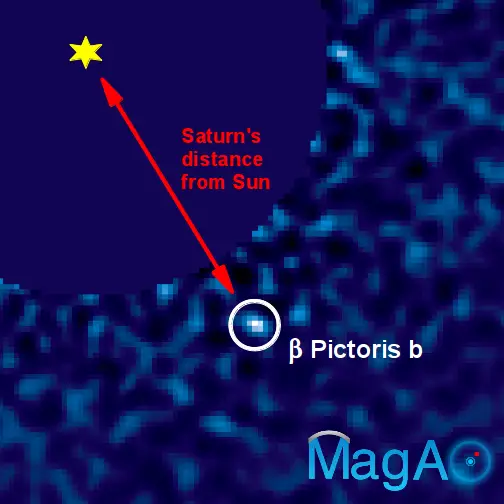
7th March 2014 New technique for direct imaging of exoplanets For the first time, astronomers have used the same imaging technology found in digital cameras to take a photo of a planet outside our Solar System with a ground-based telescope.
University of Arizona researchers have taken images of a planet outside our Solar System with an Earth-based telescope using essentially the same type of imaging sensor found in digital cameras, instead of an infrared detector. Although it still has a long way to go, this new method brings astronomers a step closer to obtaining direct images of Earth-like planets from the visible part of the light spectrum. "This is an important next step in the search for exoplanets, because imaging in visible light instead of infrared is what we likely have to do if we want to detect planets that might be suitable for harbouring life," said Jared Males, lead author on a report to be published in The Astrophysical Journal. Even though the image was taken at a wavelength just beyond human eye visibility, the use of a digital camera-type imaging sensor – known as a charge-coupled device (CCD) – opens up the possibility of imaging exoplanets in visible light, which has not been possible with Earth-based telescopes until now. So far, all Earth-based images taken of exoplanets close to their stars have been infrared images, which detect the planets' heat. This limits the technology to gas giants – massive, hot planets, still young enough to shed heat. In contrast, older and possibly habitable planets that have cooled since their formation don't show up in infrared images as readily, and to image them, astronomers will have to rely on cameras capable of detecting visible light. "Our ultimate goal is to image what we call pale blue dots," said Laird Close, a professor in the Department of Astronomy, who co-authored the paper. "After all, the Earth is blue. And that's where you want to look for other planets: in reflected blue light."
The photographed planet, Beta Pictoris b, is located approximately 63 light-years away in the constellation of Pictor, orbiting the 4th magnitude debris disk star Beta Pictoris. It orbits the star at only nine times the Earth-Sun distance, making its orbit smaller than Saturn's. In the team's CCD images, Beta Pictoris b appears about 100,000 times fainter than its host star, making it the faintest object imaged so far at such high contrast and at such relative proximity to its star. New images of this planet helped to confirm that its atmosphere is at a temperature of roughly 2600 degrees Fahrenheit (1700 Kelvin). It is estimated that Beta Pictoris b has a radius about 65% larger than Jupiter's. "Because the Beta Pictoris system is 63.4 light years from Earth, the scenario is equivalent to imaging a dime right next to a lighthouse beam from more than four miles away," Males said. "Our image has the highest contrast ever achieved on an exoplanet that is so close to its star."
As well as the host star's overwhelming brightness, the astronomers had to overcome turbulence in Earth's atmosphere, which causes stars to twinkle and images to blur. The success reported here is mostly due to an adaptive optics system developed by Close and his team that eliminates much of the atmosphere's effect. The Magellan Adaptive Optics technology is very good at removing this turbulence, or blurring, by means of a deformable mirror changing shape 1,000 times each second in real time. Adaptive optics have been used for more than 20 years at observatories in Arizona – most recently at the Large Binocular Telescope – and the latest version has now been deployed in the high desert of Chile at the Magellan 6.5-metre telescope. The team also imaged the planet with both of MagAO's cameras, giving the scientists two completely independent simultaneous images of the same object in infrared, as well as bluer light, to compare and contrast. "An important part of signal processing is proving that the tiny dot of light is really a planet and not a speckle of noise," said Katie Morzinski, a member of the MagAO team. "I obtained the second image in the infrared spectrum – at which the hot planet shines brightly – to serve as an unequivocal control that we are indeed looking at the planet. Taking the two images simultaneously helps to prove the planet image on the CCD is real and not just noise."
Comments »
|










